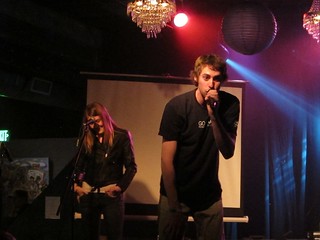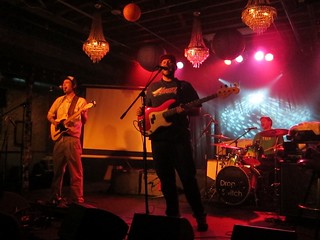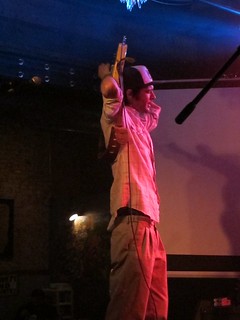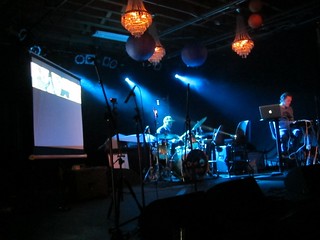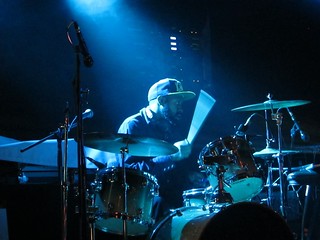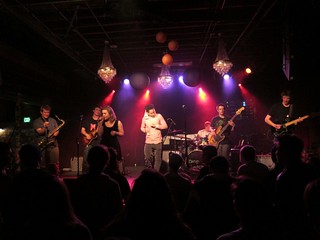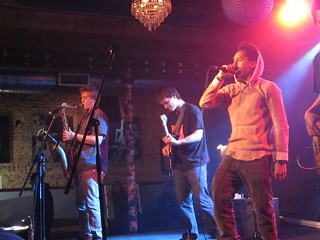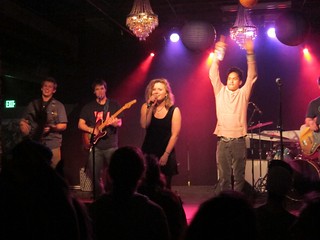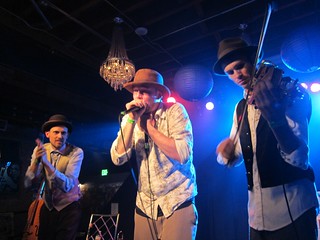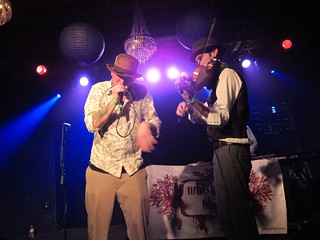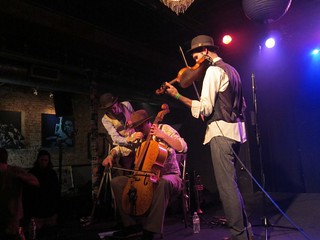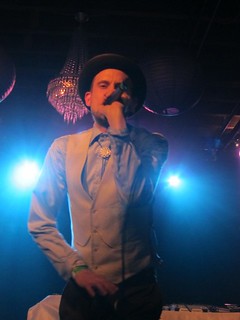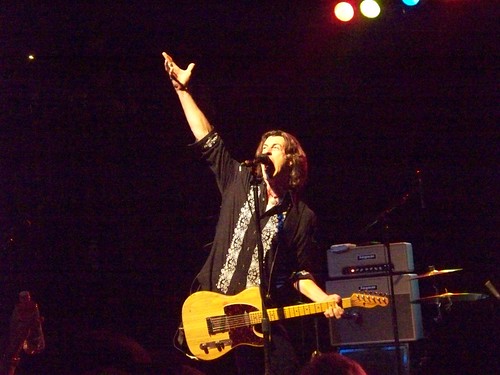27 November 2013 (Marquis Theatre, Denver CO)
What am I thankful for?
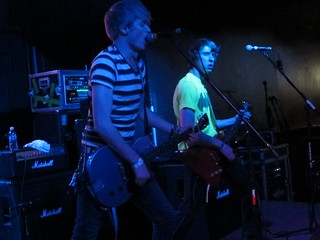 Naming a band after a Clash song sets a high bar that demands an over the top performance. Fueled by a raw, unpolished stage presence, the band's sound borrowed more from Green Day than their namesake inspiration. The lead singer, Cody Brubaker, coiled up behind the mic like he was ready to take on the whole bar. The second guitarist moved around a bit as well, but channeled most of his focus into his playing.
Naming a band after a Clash song sets a high bar that demands an over the top performance. Fueled by a raw, unpolished stage presence, the band's sound borrowed more from Green Day than their namesake inspiration. The lead singer, Cody Brubaker, coiled up behind the mic like he was ready to take on the whole bar. The second guitarist moved around a bit as well, but channeled most of his focus into his playing.
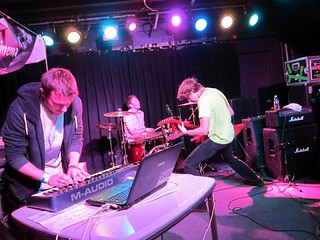
The instrumental line up was unconventional: two guitar, drums, and a keyboard providing some bass and most of the leads. They played well enough, but their presentation has a ways to go to catch up with the other acts on the bill. In particular, I didn't notice the keyboard player interact with the rest of the band, much less the audience. He partially made up for it with some solid playing, especially on one poppy, new wave tune ("Dance"?) where he locked in synch with the guitar for a tight, twinned section.
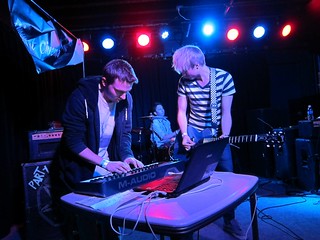
The band's original songs were strong and Brubaker did a good job of selling them. That said, their cover of Social Distortion's "Far Behind" got the biggest crowd response during the set.
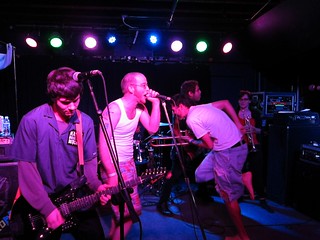 As a hardcore ska punk fan, I was primed for The A-OKs before they even started. Moments after the group packed the stage and kicked into the first song, all those expectations were satisfied. Solid horn section? Check. High energy beats and a staccato bassline? Check? Guitar nailing the chank but capable of thrashy leads? Check. Charismatic frontman who could harness the rambunctious energy of his band and magnify it into a non-stop spectacle? Check and double check!
As a hardcore ska punk fan, I was primed for The A-OKs before they even started. Moments after the group packed the stage and kicked into the first song, all those expectations were satisfied. Solid horn section? Check. High energy beats and a staccato bassline? Check? Guitar nailing the chank but capable of thrashy leads? Check. Charismatic frontman who could harness the rambunctious energy of his band and magnify it into a non-stop spectacle? Check and double check!
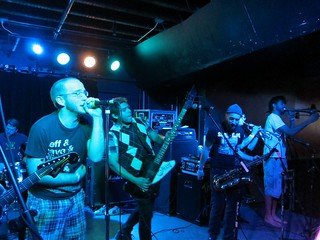
That energy is the key to ska punk. It's an alchemical transformation of Brownian motion on stage into a free-for-all party in the crowd. The musicians caromed off one another, trading grins and knowing looks. When the horns periodically dropped out, they never stood idle; they flailed and bounced along to the beat. The audience fed off this excitement and began to wake up. Lead singer Mark Swan had no problem helping the process along. Early in the set, he leaped into the crowd to jump-start a skanking mosh pit while the band ground into a heavy punk groove.
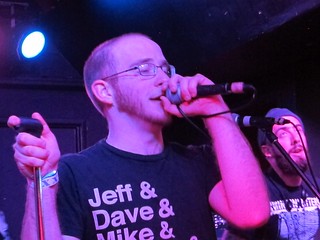
All of the players were expressive, making every moment more of a show, but Swan and Mark Malpezzi were the clown princes. When he wasn't blowing sax, Malpezzi roamed the stage, taunting and teasing his bandmates or mouthing along with the lyrics. Swan played a host of characters. One song would have him raging against the world and the next would evoke a bemused goofiness.

The style also supports a good mix of anger and sarcastic wit. The A-OKs' songs did a great job of pulling in everything from sucker-punch metal leads and cathartic punk flail to tight horn riffs and smooth vocal harmonies. Individual tunes like "Brain Bucket" effectively flipped from pop-punk sneer to chop beats and horn fills and back. This was a rock solid performance that would be very hard to follow up.
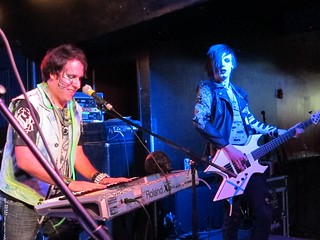 Fortunately, Discount Cinema made a strong visual impact as soon as they hit the stage. Each musician expressed their own persona, from Kevin Dallas' anarcho-punk to Ian Gray's feral night-feeder. Bass player Gray was especially focused, never breaking character. The band matched their striking look with well-orchestrated songs and a theatrical performance. Lead singer/keyboardist Jordan Niteman comfortably filled the role of front man for the band, spending as much time interacting with the audience as he did behind the keys.\
Fortunately, Discount Cinema made a strong visual impact as soon as they hit the stage. Each musician expressed their own persona, from Kevin Dallas' anarcho-punk to Ian Gray's feral night-feeder. Bass player Gray was especially focused, never breaking character. The band matched their striking look with well-orchestrated songs and a theatrical performance. Lead singer/keyboardist Jordan Niteman comfortably filled the role of front man for the band, spending as much time interacting with the audience as he did behind the keys.\

The band's hard, heavy edge had the Gothic undertones to match their artful appearance, but it was hard to pigeonhole their sound. The keys added a post-punk/synth-pop vibe, but there was a fair amount of metal shred and punk slash in the mix as well. Drummer Steve Zimmerman provided the thunder to Dallas' guitar lightning, but the songs magnified their punch with adroitly handled dynamic drops.
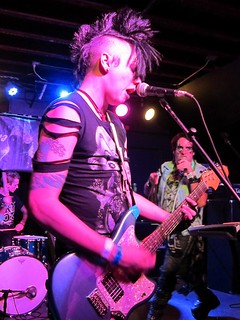
Discount Cinema largely relied on Niteman to connect with the crowd along with their flash appearance. They finally broke that pattern when Dallas took the mic to make a few sincere remarks. His theme of self-acceptance resonated with the audience, although it provided an interesting introduction for the band's next song, a cover of Miley Cyrus' "Wrecking Ball". Ironic punk covers of pop music are fairly common, but the band tapped into the roiling emotion of the lyrics and let it vent.

The band finished on their song, "Dreamcatcher", packed with insistent new wave shadows.The ominous bridge built up the tension, but the catchy chorus closed out the tune, transforming it into an ear worm that lingered well after they left the stage.
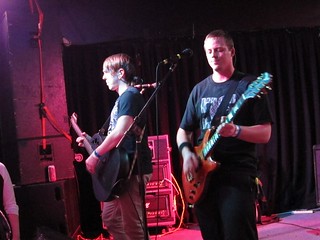 Skyfox wrapped up the evening out with a strong set that showcased bandleader Johnny Hill's cocky persona. He and bass player Matt Lase provided the stage patter that created a relaxed impression while it shaped the flow of songs. They kicked off their show with a big, pre-recorded entrance. At first, it seemed self-indulgent, but they quickly brought enough humor to reveal the irony. A staged ending/encore closed the show in a similar manner.
Skyfox wrapped up the evening out with a strong set that showcased bandleader Johnny Hill's cocky persona. He and bass player Matt Lase provided the stage patter that created a relaxed impression while it shaped the flow of songs. They kicked off their show with a big, pre-recorded entrance. At first, it seemed self-indulgent, but they quickly brought enough humor to reveal the irony. A staged ending/encore closed the show in a similar manner.
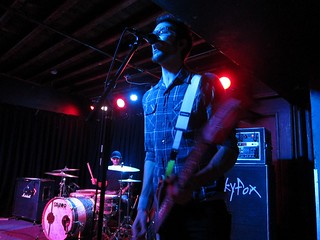
Compared to Discount Cinema, Skyfox had a much more natural presence, but they worked the space just as aggressively. Guitarist Mike Rich migrated from one side to the other to involve the whole front line of the stage and Hill struck his own set of guitar god poses. Their pop-punk tunes were tight and clever, reminding me more of Bowling For Soup than Green Day even though Hill's voice is closer to Billie Joe Armstrong's. Songs like "Counter Counter Culture" managed to cram in social commentary, self-deprecating irony, and hard-driving guitars.
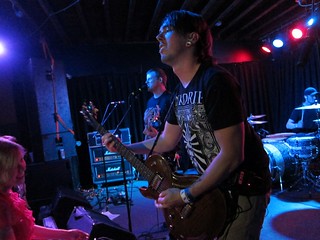
Even though most their songs fell into my favorite "snotty boys with guitars" sweet spot, they took one detour for a moving song about Hill's father's death, called "Our Last Breath". Arranged for two acoustic guitars and pre-recorded strings, it provided a sweet, sentimental moment. Where the rest of the set built up the band as glib and a bit arrogant, this risky but powerful tune showed Skyfox's wider emotional range.
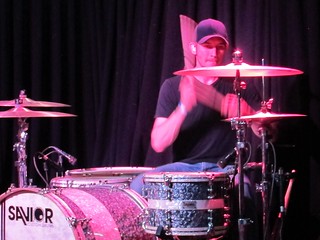
More photos on my Flickr.
What am I thankful for?
Bands that play small shows and still rock their guts outThis was a pre-Thanksgiving show that offered a strong mix of local acts. Two pop-punk focused bands bookended the night with a couple of wildcards tossed in the middle.
To crowds of their friends who love them and must shout
Drummers that pound as the guitar tone sings,
These are a few of my favorite things.
 Naming a band after a Clash song sets a high bar that demands an over the top performance. Fueled by a raw, unpolished stage presence, the band's sound borrowed more from Green Day than their namesake inspiration. The lead singer, Cody Brubaker, coiled up behind the mic like he was ready to take on the whole bar. The second guitarist moved around a bit as well, but channeled most of his focus into his playing.
Naming a band after a Clash song sets a high bar that demands an over the top performance. Fueled by a raw, unpolished stage presence, the band's sound borrowed more from Green Day than their namesake inspiration. The lead singer, Cody Brubaker, coiled up behind the mic like he was ready to take on the whole bar. The second guitarist moved around a bit as well, but channeled most of his focus into his playing.
The instrumental line up was unconventional: two guitar, drums, and a keyboard providing some bass and most of the leads. They played well enough, but their presentation has a ways to go to catch up with the other acts on the bill. In particular, I didn't notice the keyboard player interact with the rest of the band, much less the audience. He partially made up for it with some solid playing, especially on one poppy, new wave tune ("Dance"?) where he locked in synch with the guitar for a tight, twinned section.

The band's original songs were strong and Brubaker did a good job of selling them. That said, their cover of Social Distortion's "Far Behind" got the biggest crowd response during the set.
 As a hardcore ska punk fan, I was primed for The A-OKs before they even started. Moments after the group packed the stage and kicked into the first song, all those expectations were satisfied. Solid horn section? Check. High energy beats and a staccato bassline? Check? Guitar nailing the chank but capable of thrashy leads? Check. Charismatic frontman who could harness the rambunctious energy of his band and magnify it into a non-stop spectacle? Check and double check!
As a hardcore ska punk fan, I was primed for The A-OKs before they even started. Moments after the group packed the stage and kicked into the first song, all those expectations were satisfied. Solid horn section? Check. High energy beats and a staccato bassline? Check? Guitar nailing the chank but capable of thrashy leads? Check. Charismatic frontman who could harness the rambunctious energy of his band and magnify it into a non-stop spectacle? Check and double check!
That energy is the key to ska punk. It's an alchemical transformation of Brownian motion on stage into a free-for-all party in the crowd. The musicians caromed off one another, trading grins and knowing looks. When the horns periodically dropped out, they never stood idle; they flailed and bounced along to the beat. The audience fed off this excitement and began to wake up. Lead singer Mark Swan had no problem helping the process along. Early in the set, he leaped into the crowd to jump-start a skanking mosh pit while the band ground into a heavy punk groove.

All of the players were expressive, making every moment more of a show, but Swan and Mark Malpezzi were the clown princes. When he wasn't blowing sax, Malpezzi roamed the stage, taunting and teasing his bandmates or mouthing along with the lyrics. Swan played a host of characters. One song would have him raging against the world and the next would evoke a bemused goofiness.

The style also supports a good mix of anger and sarcastic wit. The A-OKs' songs did a great job of pulling in everything from sucker-punch metal leads and cathartic punk flail to tight horn riffs and smooth vocal harmonies. Individual tunes like "Brain Bucket" effectively flipped from pop-punk sneer to chop beats and horn fills and back. This was a rock solid performance that would be very hard to follow up.
 Fortunately, Discount Cinema made a strong visual impact as soon as they hit the stage. Each musician expressed their own persona, from Kevin Dallas' anarcho-punk to Ian Gray's feral night-feeder. Bass player Gray was especially focused, never breaking character. The band matched their striking look with well-orchestrated songs and a theatrical performance. Lead singer/keyboardist Jordan Niteman comfortably filled the role of front man for the band, spending as much time interacting with the audience as he did behind the keys.\
Fortunately, Discount Cinema made a strong visual impact as soon as they hit the stage. Each musician expressed their own persona, from Kevin Dallas' anarcho-punk to Ian Gray's feral night-feeder. Bass player Gray was especially focused, never breaking character. The band matched their striking look with well-orchestrated songs and a theatrical performance. Lead singer/keyboardist Jordan Niteman comfortably filled the role of front man for the band, spending as much time interacting with the audience as he did behind the keys.\
The band's hard, heavy edge had the Gothic undertones to match their artful appearance, but it was hard to pigeonhole their sound. The keys added a post-punk/synth-pop vibe, but there was a fair amount of metal shred and punk slash in the mix as well. Drummer Steve Zimmerman provided the thunder to Dallas' guitar lightning, but the songs magnified their punch with adroitly handled dynamic drops.

Discount Cinema largely relied on Niteman to connect with the crowd along with their flash appearance. They finally broke that pattern when Dallas took the mic to make a few sincere remarks. His theme of self-acceptance resonated with the audience, although it provided an interesting introduction for the band's next song, a cover of Miley Cyrus' "Wrecking Ball". Ironic punk covers of pop music are fairly common, but the band tapped into the roiling emotion of the lyrics and let it vent.

The band finished on their song, "Dreamcatcher", packed with insistent new wave shadows.The ominous bridge built up the tension, but the catchy chorus closed out the tune, transforming it into an ear worm that lingered well after they left the stage.
 Skyfox wrapped up the evening out with a strong set that showcased bandleader Johnny Hill's cocky persona. He and bass player Matt Lase provided the stage patter that created a relaxed impression while it shaped the flow of songs. They kicked off their show with a big, pre-recorded entrance. At first, it seemed self-indulgent, but they quickly brought enough humor to reveal the irony. A staged ending/encore closed the show in a similar manner.
Skyfox wrapped up the evening out with a strong set that showcased bandleader Johnny Hill's cocky persona. He and bass player Matt Lase provided the stage patter that created a relaxed impression while it shaped the flow of songs. They kicked off their show with a big, pre-recorded entrance. At first, it seemed self-indulgent, but they quickly brought enough humor to reveal the irony. A staged ending/encore closed the show in a similar manner.
Compared to Discount Cinema, Skyfox had a much more natural presence, but they worked the space just as aggressively. Guitarist Mike Rich migrated from one side to the other to involve the whole front line of the stage and Hill struck his own set of guitar god poses. Their pop-punk tunes were tight and clever, reminding me more of Bowling For Soup than Green Day even though Hill's voice is closer to Billie Joe Armstrong's. Songs like "Counter Counter Culture" managed to cram in social commentary, self-deprecating irony, and hard-driving guitars.

Even though most their songs fell into my favorite "snotty boys with guitars" sweet spot, they took one detour for a moving song about Hill's father's death, called "Our Last Breath". Arranged for two acoustic guitars and pre-recorded strings, it provided a sweet, sentimental moment. Where the rest of the set built up the band as glib and a bit arrogant, this risky but powerful tune showed Skyfox's wider emotional range.

More photos on my Flickr.
 Songs or albums? For most people, it’s no contest. Picking and choosing single tracks lets them winnow the pearls from the crappy packing material that some bands use to pad out their albums. Through playlists or iTunes shuffle, juxtaposing bands and songs provides novelty and synchronicity, satisfying the need for variety. Then a band like
Songs or albums? For most people, it’s no contest. Picking and choosing single tracks lets them winnow the pearls from the crappy packing material that some bands use to pad out their albums. Through playlists or iTunes shuffle, juxtaposing bands and songs provides novelty and synchronicity, satisfying the need for variety. Then a band like 
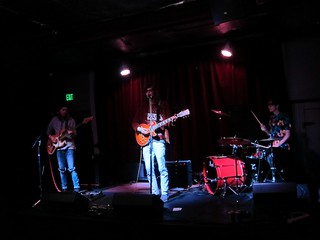
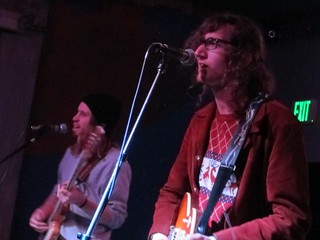
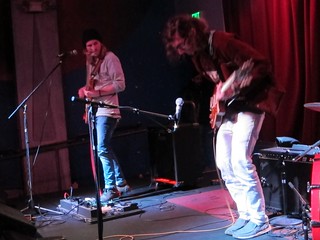
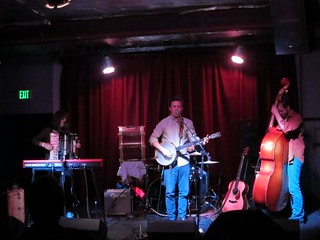
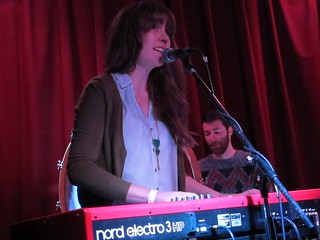

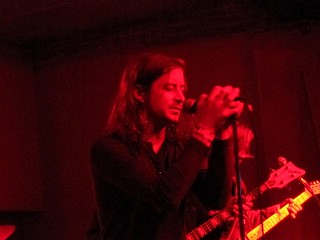
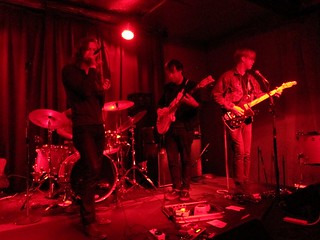
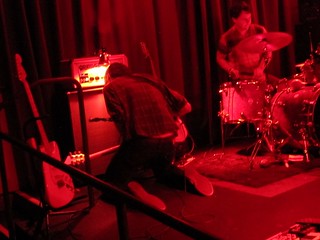
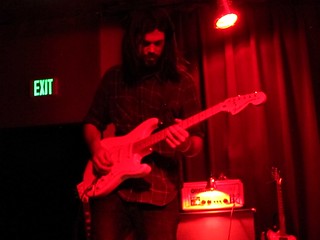
 This is a mashup interview. I conducted separate interviews with five of my favorite mashup artists, some by phone and others by email. Afterwards, mirroring their creative approach, I created this collage interview as a Mashup Artist Summit. None of these artists were aware of how their interviews would be combined, but rather than warp their words for surprise or humorous effect, I've attempted to keep their ideas intact while recognizing their related perspectives on mashups.
This is a mashup interview. I conducted separate interviews with five of my favorite mashup artists, some by phone and others by email. Afterwards, mirroring their creative approach, I created this collage interview as a Mashup Artist Summit. None of these artists were aware of how their interviews would be combined, but rather than warp their words for surprise or humorous effect, I've attempted to keep their ideas intact while recognizing their related perspectives on mashups.
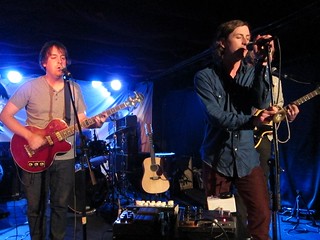
 Everybody knows that first impressions are important. With short attention spans, people are quick to categorize and move on. Sometimes, those kneejerk responses are spot-on and sometimes they miss the mark. Either way, there’s rarely a chance to reset expectations after that initial impact. On Cut Yourself Free, guitarist
Everybody knows that first impressions are important. With short attention spans, people are quick to categorize and move on. Sometimes, those kneejerk responses are spot-on and sometimes they miss the mark. Either way, there’s rarely a chance to reset expectations after that initial impact. On Cut Yourself Free, guitarist 
 I can’t separate The Charity of Night from a thick, smoky Amsterdam evening at the Melkweg in March of 1997. After a day wandering through museums, bars and coffee shops, my friend insisted on catching
I can’t separate The Charity of Night from a thick, smoky Amsterdam evening at the Melkweg in March of 1997. After a day wandering through museums, bars and coffee shops, my friend insisted on catching 